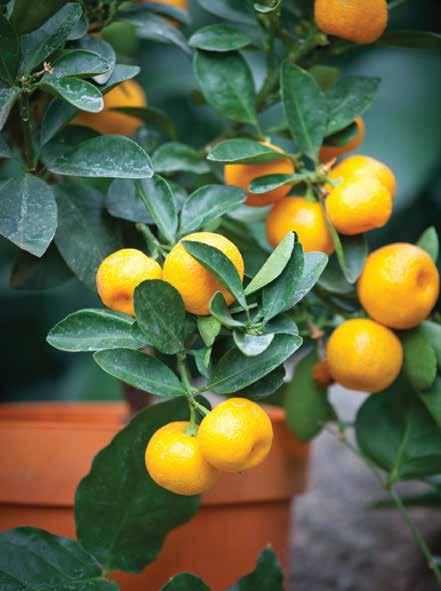Indoor Gardening: Non-Stop Citrus
A
s a plant lover living in the Midwest, it’s easy to fall into the “overwintering mindset.” October ice storms and frigid Februarys aren’t exactly conducive to year-round food production, especially tropical and subtropical fruit. Those conditions are more likely to result in plane tickets to the Caribbean where you can fulfill your daydreams of plucking fresh limes along the roadside any day of the year. The concept of overwintering is completely normal, though. As days grow shorter and temperatures decline, the pivot from production to preservation is dictated by nature and the changing seasons. We should feel a sense that it’s time to hunker down and hibernate. It’s an inherent animal instinct for our protection and safety, helping us survive harsh winter environments. While that thinking worked well for our ancestors, human ingenuity has since developed a new toolset, allowing us to do more than just survive the winters. Now we can thrive with heaters, insulation, lightbulbs and a myriad of other inventions that we often take for granted. Similarly, our plants can capitalize on human technological achievements. Let’s look at how this applies to a group of the most commonly overwintered plants grown for food production, citrus trees. For anyone who is already growing citrus in the Midwest, you know that below-freezing temperatures and rapid swings in temperature can really damage your trees. That typically relegates them to sunny windows and heated garages throughout the fall and winter, waiting to be released back to the porch, garden or yard during the warm spring and summer months. For half the year they flourish under the sun’s intense glow, and for the other half they simply survive.
Fortunately, through advances in lighting technology, the penetrating rays of the summer sun can be reproduced within our own homes. That’s excellent news for citrus lovers who can give their trees a
Yes, it is possible to grow citrus year round. full year of optimal growing conditions rather than taking every six months off to overwinter. Lemons, limes, oranges, grapefruit, kumquats, nothing is off limits! Citrus grows best under 12 to 16 hours of strong, direct light per day. When choosing a grow light, look for high output T5 fluorescents (ideally a 4-bulb fixture), an LED (light emitting diode) using 100 or
JASON MISPAGEL Indoor Gardener 12
December 2021 | kcgmag.com
more watts of electricity, or a CMH (ceramic metal halide). Regardless the style of light, it’s ideal to have a full spectrum of color temperature in order to more closely replicate natural sunlight. Fluorescents and
LEDs will need to be placed about a foot above the top of each plant, whereas CMH bulbs should rest 2-3 feet above the canopy. Ideal temperatures can be slightly more difficult to maintain indoors (especially if you’re trying to keep your heating bill down). 70°F to 90°F is a comfortable range for citrus, with higher temperatures encouraging more rapid growth
and lower temperatures triggering blooming/fruit development. Placing your plant in a grow tent is a simple way to help boost temperatures by trapping the heat emitted from your grow lights. If your environment is particularly chilly, consider intentionally choosing a grow light that puts off a lot of heat such a CMH. In addition to bright light and warm temperatures, citrus plants can be particular about their soil. They prefer a well-draining grow media with slightly acidic pH (5.5 to 6.5). Prolonged oversaturation with water should be avoided as it prevents necessary oxygen from reaching the roots. Fertilize with high levels of nitrogen (N) and low levels of phosphorous (P) and potassium (K). For example, an N-P-K ratio of 3:1:1 would work nicely. There are also citrus-specific fertilizers like FoxFarm Happy Frog Citrus & Avocado (7:3:3), formulated particularly for indoorplants, that include ingredients like beneficial fungi and micronutrients (i.e., calcium, sulfur, etc.). Be sure to follow the dosage recommendations on the product’s packaging, as feeding amounts may change from brand-to-brand. With those few environmental controls in place, your favorite citrus varieties never have to slow down during the winter again. When you feel it’s time to start producing fruit, simply lower the temperature towards the bottom of the acceptable range and watch the flowers start to bloom. Instead of flying to Jamaica in January to get your citrus fix, you can simply pluck fresh fruit without ever leaving the house. Challenging as it may be, I hope you too can break free of the overwintering mindset and continue producing fresh, nutritious food indoors…even when the world outside your window has gone to sleep until spring.
Jason Mispagel is the co-owner and operator of Year-Round Garden, a grower’s supply center serving both home and commercial customers since 2016. To contact Jason, call 816-216-6917 or jason@year-roundgarden.com.






